Introduction
In the gymnasium, whether it is an exciting sports event or a wonderful concert, the audience’s eyes are always on the huge LED display screen.
But have you ever thought about how to make the viewing angle of this screen larger so that the audience in every corner can enjoy the best visual experience?
Table of Contents
1. Where is the LED display screen in the gymnasium generally installed?

1). Above the audience’s head
This position is very common, usually under the dome of the gymnasium or above the second-floor stands of the audience seats.
Imagine that you are watching a game in the gymnasium and you can see a large screen when you look up.
This screen is generally used to display real-time data of the game, replays of exciting moments, and close-ups of players.
For example, in a basketball game, if a player completes a super cool dunk, the LED screen above his head can immediately replay the action, allowing the audience to reminisce, which is particularly enjoyable.
Moreover, the screen in this position can be seen by the entire audience; whether you are sitting in the front row or the back row, you can clearly see the content on the screen.
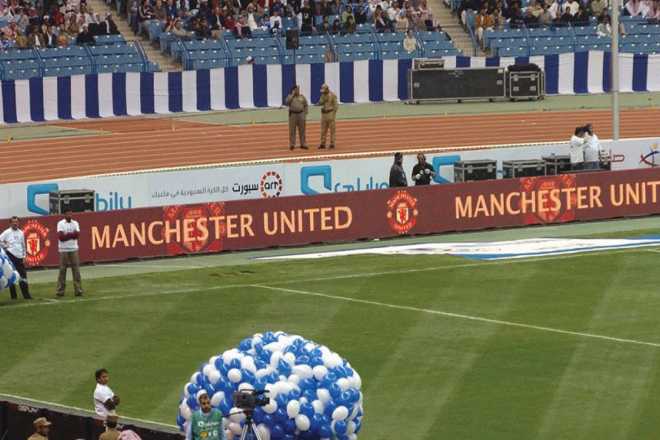
2). Around the venue
Around the edge of the venue, a circle of LED screens are installed in front of the first row of seats.
The screens in this position are mainly for the convenience of the audience to see the information on the screen without turning their eyes too far when watching the game.
For example, in a football game, the LED screens around the venue can display the score, game time, and sponsor advertisements in real-time.
In this way, while watching the game, the audience can also keep up to date with the latest situation of the game and will not miss any exciting moments.
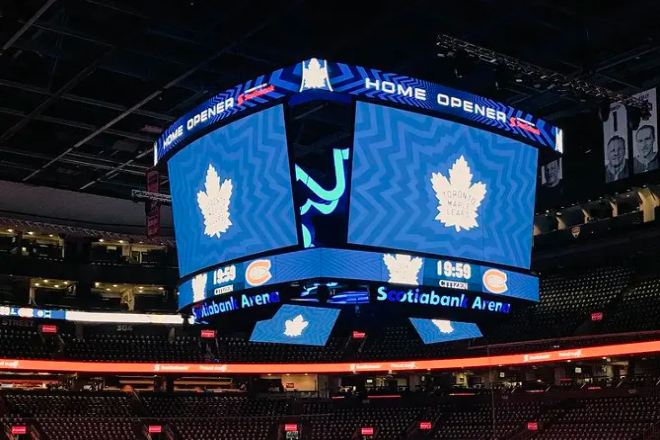
3). Above the centre of the venue
The LED screens in this position are generally large hanging screens, and many of them are multi-sided screen designs, such as four-sided screens or six-sided screens.
The advantage of this screen is that no matter which direction the audience sits, they can see the content on the screen.
It is mainly used to play back the highlights of the game, close-up shots of the players, and event information.
For example, in large concerts or sports events, the LED screen above the centre of the venue can show the details of the singer’s performance or the exciting movements of the athletes, making the audience feel like they are at the scene.
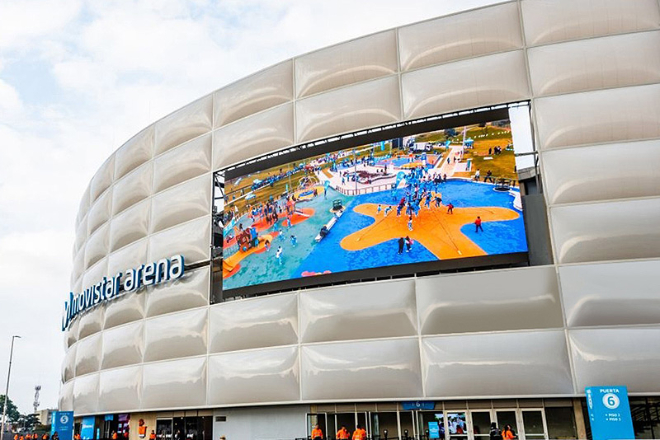
4). Entrance or lobby
The LED screen is installed at the entrance or lobby of the gymnasium, mainly to allow the audience to see relevant information as soon as they enter.
For example, during large-scale sports events, the LED screen at the entrance can display the day’s game schedule, information about participating teams, and the layout of the venue.
In this way, the audience can quickly understand the information they need as soon as they enter, making it easier for them to find seats or go to where they want to go.
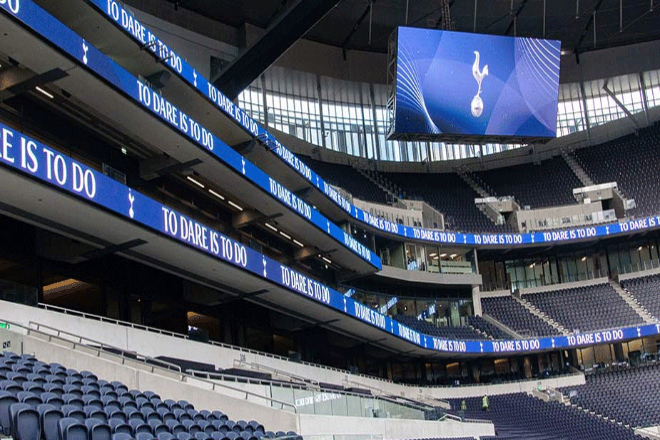
5). Both sides of the audience seats
Install screens in the middle of both sides of the audience seats. The screens in this position are mainly for the audience on both sides to see game data and player information.
For example, in volleyball games, the LED screens on both sides of the audience seats can display information such as the player’s score and number of spikes.
In this way, when watching the game, the audience can understand the player’s performance while watching the game, which increases the fun of watching the game.
6). Rest area or corridor
Install LED screens in the rest area or corridor of the gymnasium. The screens in this position are mainly used to display some event information, venue facility introductions, and commercial advertisements.
For example, in the rest area of the gymnasium, the LED screen can display information about the upcoming game or catering service information in the venue.
In this way, the audience can also learn some useful information during their breaks, and watch advertisements by the way, and maybe find something they are interested in.
In short, the selection of these locations is to allow the audience to easily see the content on the screen at different locations without affecting their viewing of the game.
Each location has its advantages, and the specific installation location depends on the structure and actual needs of the stadium.
2. Why is the viewing angle so important for the stadium LED display?
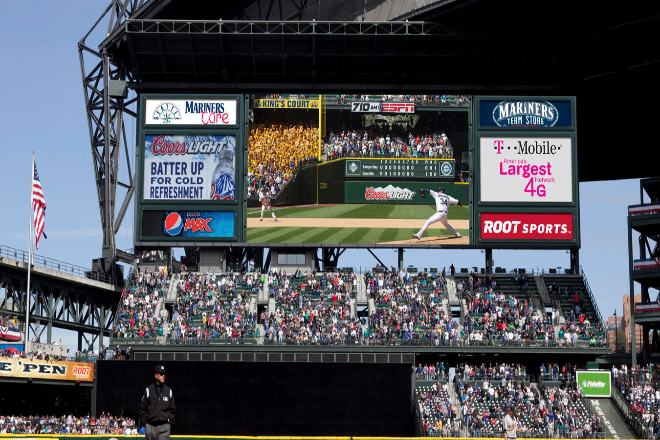
The auditorium of the stadium is usually large, and the audience is distributed in different areas and angles.
If the viewing angle is not wide enough, the audience sitting on the side or far away may find it difficult to see the content on the screen.
For example, the audience sitting in the corner may see that the screen is crooked, or can only see part of the screen, which affects their viewing experience.
A good viewing angle ensures that the content on the screen is clearly visible to all viewers.
Imagine if the screen has a narrow viewing angle, and the audience slightly deviates from the front of the screen, the text or picture on the screen will become blurred or the color will be distorted.
This will not only make the audience miss important information, but also make them feel that the screen looks uncomfortable.
LED displays with good viewing angles allow viewers to enjoy high-quality visual experiences at any position.
For example, in large-scale sports events, viewers can see replays of exciting moments, close-ups of players, etc., through the screen.
If the viewing angle is not good, these exciting contents cannot be seen by all viewers, which greatly reduces the fun of watching the game.
The LED display screens in stadiums are not only used for competitions, but also for other activities such as concerts and performances.
In these occasions, the positions of the audience are more diverse, and the importance of viewing angles is more prominent.
For example, in a concert, the audience may sit in all directions of the stage. A screen with a good viewing angle can ensure that every audience member can clearly see the performance details on the stage.
If the viewing angle is not good, the audience needs to constantly adjust their position or angle to see the screen clearly, which can easily lead to visual fatigue.
A screen with a good viewing angle allows the audience to watch easily without frequently adjusting their sight, thereby improving their comfort.
From a commercial perspective, LED displays with a good viewing angle can better display advertising content.
If the viewing angle of the screen is very narrow, only the audience in front can see the advertisement, and the effect of the advertisement will be greatly reduced.
A screen with a wide viewing angle can ensure that all viewers can see the advertisement, thereby increasing the exposure and commercial value of the advertisement.
Different stadiums have different structures; some are round, some are oval, and some are rectangular.
LED displays with good viewing angles can better adapt to various venue structures, ensuring that viewers can see clear pictures at all positions regardless of the shape of the venue.
In short, the viewing angle is as important to the stadium LED display as the field of vision of the eyes. It determines what the audience can see and how clearly they can see it.
A good viewing angle allows the audience to enjoy a high-quality visual experience at any position, which is why the viewing angle is particularly valued when designing and installing LED displays.
3. Analysis of factors affecting the viewing angle of the stadium LED display
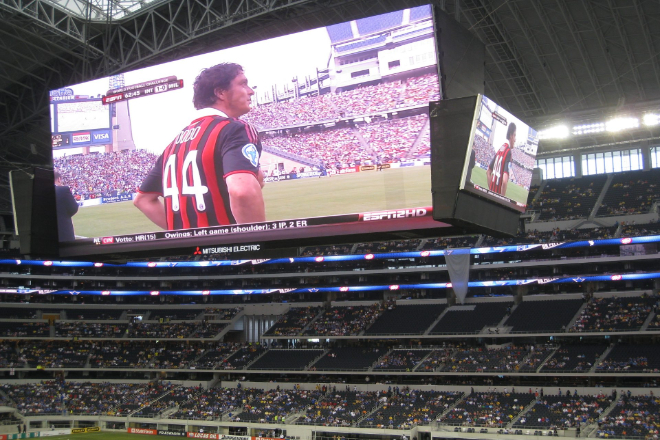
1). Installation position of the display
1.1). The relationship between height, angle and audience’s sight
If the screen is installed too high, the audience will have to look up, and their necks will get tired after a long time; if it is too low, it will be easily blocked by the people in front.
The angle of the LED screen is also very important. A slight tilt can reduce reflections and make the picture clearer.
Therefore, the height and angle of the screen should be adjusted according to the position of the audience seats to make the audience feel comfortable.
1.2). Horizontal distance and vertical distance from the audience seats
If the LED screen is too far away from the audience, the picture will appear small, and the edges will be blurred; if it is too high or too low, the viewing angle will be narrowed or blocked.
The screen should be installed in a suitable position according to the slope and distribution of the audience seats to ensure that the audience can see a complete and clear picture no matter where they sit.
2). The size of the display screen
2.1). The influence of area size on the viewing angle range
The larger the LED screen, the more complete the picture the audience can see and the wider the viewing angle range. But the screen is too large, the cost is high, and the installation is troublesome.
Therefore, the screen size should be determined according to the size of the gymnasium and the distribution of the audience seats. It should be clear and take into account the budget and installation conditions.
2.2). Matching the aspect ratio with the optimal viewing range
Common LED screen ratios are 16:9 and 4:3. 16:9 is suitable for widescreen videos, allowing viewers to see a more complete scene; 4:3 is suitable for traditional TV screens but is rarely used in modern stadiums.
The LED screen ratio should be selected according to the shape of the stadium and the layout of the auditorium to avoid stretching or compression of the picture, so that the audience can see a comfortable picture at all positions.
3). Pixel density of the display screen
3.1). The relationship between pixel pitch and display clarity
The smaller the pixel pitch, the clearer the LED screen. For example, the P2.5 screen is clearer than the P5 screen.
However, if the pixel pitch is too small, the cost is high, and the audience at a distance may not feel much difference.
Therefore, it is necessary to select the appropriate pixel pitch according to the audience distance and budget to ensure that the picture is clear and economical.
3.2). The impact of clarity on the viewing angle of long-distance viewing
The clarity of the LED screen directly affects the viewing effect of long-distance viewers. With high clarity, the audience can see more details.
With low clarity, the picture is blurred, the viewing angle range becomes narrower, and the audience is prone to fatigue.
Therefore, the screen clarity should be high enough to allow the audience to have a good visual experience at all positions.
4). Brightness and contrast of the display screen
4.1). Display effect under different ambient lighting
The lighting in the gymnasium is complex, and the brightness and contrast of the LED screen should be adjusted according to the light.
When the sun is shining directly, the screen should be bright enough; at night or in dim light, the screen should not be too bright.
The contrast is high, the picture is black and white, and the details are prominent.
Therefore, the screen brightness and contrast should be dynamically adjusted according to the ambient light to ensure that the picture is clear and comfortable.
4.2). The effect of brightness and contrast on visual comfort within the viewing angle
The LED screen is too bright or too dark, and the contrast is too high or too low, which will affect the visual comfort of the audience.
The screen brightness and contrast should be adjusted according to the audience’s position and ambient light, so that the audience can watch comfortably at all positions.
The smart screen can automatically adjust the brightness and contrast according to the light to enhance the viewing experience.
5). Curved design of the display screen
5.1). Differences in viewing angles between flat screens and curved screens
Flat screens have narrow viewing angles, and the edges are easily deformed or reflective.
Curved LED screens have wide viewing angles and scattered light, and the audience can see clear images from different angles.
Curved LED screens are more suitable for curved auditoriums, which can reduce reflections and enhance the viewing experience.
5.2). Effect of curved curvature on viewing angle expansion
The curvature of the curved screen should be moderate. If the curvature is too small, the effect is not obvious.
If the curvature is too large, the middle of the picture is prominent, and the edges are compressed.
Reasonable curvature design can expand the viewing angle range, allowing the audience to see more clearly and more comfortably.
6). Display screen splicing method
6.1). Viewing angle continuity of single-screen and multi-screen splicing
The viewing angle of a single screen is consistent, but the size is limited; multi-screen splicing can expand the display area, but the splicing gap will affect the continuity of the picture.
The splicing gap should be as small as possible, and the picture at the splicing point should be optimized to ensure the continuity of the viewing angle.
6.2). Effect of the splicing gap on viewing angle
If the splicing gap is too large, the audience will see the picture broken, affecting the mood of watching the game.
Optimizing the stitching process and software calibration can reduce the impact of gaps on viewing angles, allowing viewers to see a complete and clear picture at every position.
4. Strategies for expanding viewing angles of LED display screens in gymnasiums
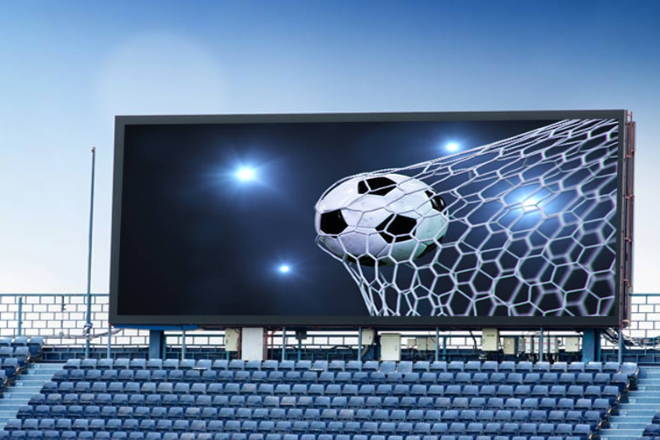
1). Optimize the installation position of the display screen
First, you need to look at the shape of the gymnasium and how the audience seats are arranged.
For example, if the audience seats are raised layer by layer, the screen cannot be installed too low, otherwise the audience in the front row will block the screen and the audience in the back row will not be able to see anything.
The screen must be installed at a suitable height according to the slope of the audience seats so that everyone can see it.
The angle is also critical. The screen cannot directly face the audience. Otherwise, the reflection will be strong, and the picture will not be clear.
The screen must be slightly tilted according to the direction of the audience seats so that the light will not easily reflect and the audience will feel comfortable watching it.
In addition, in addition to the main large screen, some auxiliary small screens can be installed in different directions of the gymnasium.
For example, small screens can be installed on both sides of the audience seats, at the entrance or in the corridor.
In this way, no matter where the audience sits, they can see the key information or exciting replays of the game.
For example, in large-scale sports events, the audience can also learn about the latest situation of the game through the auxiliary screen on the way to the bathroom or to buy drinks.
2). Choose the right screen size
The size of the stadium and the number of spectators determine how big the screen should be.
If the stadium can accommodate tens of thousands of people, the screen will be too small, and the audience sitting far away will only see a blurry shadow.
According to the size of the stadium and the number of spectators, a suitable screen area should be calculated so that everyone can see clearly.
For example, in a large stadium that can accommodate 50,000 people, the main screen area in the centre of the venue may have to reach hundreds of square meters so that the audience far away can also see the picture clearly.
The aspect ratio of the screen is also very important. Generally speaking, the 16:9 ratio is more common. The picture with this ratio looks more natural and is suitable for playing game replays or concerts.
However, if the shape of the stadium is special, such as round or oval, the aspect ratio may have to be adjusted to make the screen better fit the layout of the audience seats.
For example, in an oval stadium, the aspect ratio of the screen can be slightly adjusted so that the audience can see a complete and comfortable picture at all positions.
3). Increase the pixel density of the display
The smaller the pixel pitch, the clearer the screen picture. In places like gymnasiums where the audience is far away from the screen, screens with small pixel pitches allow the audience to see the details of the picture from a distance.
For example, a P2.5 screen (pixel pitch 2.5 mm) is much clearer than a P5 screen (pixel pitch 5 mm).
Although the cost of a screen with a small pixel pitch is higher, it is a worthwhile investment from the audience’s viewing experience.
Although screens with small pixel pitches look tempting, cost is also a factor that needs to be considered.
If the budget of the gymnasium is limited, high pixel density cannot be pursued blindly. You can choose a suitable pixel pitch according to the actual needs of the venue.
For example, for some small gymnasiums or situations with limited budgets, you can choose a P4 or P5 screen, which can ensure a certain degree of clarity without making the cost too high.
4). Adjust the brightness and contrast of the display
The light in the gymnasium will change; sometimes, the sun shines directly in, and sometimes, it is very dark. The brightness of the screen must be adjusted according to the light conditions.
For example, when the sun is shining, the screen needs to be brighter. Otherwise, the audience will not be able to see clearly.
At night or when the light is dim, the screen needs to be dimmed. Otherwise, it will be dazzling.
Now, many screens have intelligent adjustment functions that can automatically adjust the brightness according to the light, which is very convenient.
Contrast is also very important. A screen with high contrast can make the black and white of the picture clearer and the details more prominent.
For example, when playing the highlights of the game, high contrast allows the audience to see the players’ movements and expressions more clearly.
Moreover, the high-contrast screen can also expand the effective viewing angle, allowing the audience to see clear and comfortable pictures from different angles.
5). Use a curved display design
Curved screens have more advantages than flat screens because they allow the audience to see a complete and clear picture from different angles.
It is important to choose the right curvature of the curve. If the curvature is too small, the effect is not obvious.
If the curvature is too large, the picture will be distorted. You have to choose a suitable curvature according to the layout of the stadium’s audience seats and the size of the screen.
For example, for the main screen in the centre of the venue, you can choose a moderate curvature so that the audience can see a complete and clear picture in all directions.
In addition to functional considerations, the design of the curved screen must also match the architectural style of the stadium.
For example, if the design of the stadium is more modern and fashionable, the shape of the curved screen can also be more unique.
If the design of the stadium is more traditional, the shape of the curved screen must be relatively simple. This will not only make the audience feel comfortable, but also make the overall style of the stadium more coordinated.
6). Improve the display screen splicing technology
If the screen is spliced together in multiple pieces, the splicing gap will affect the audience’s viewing experience.
Seamless splicing or micro-seam splicing technology can reduce the splicing gap and make the picture look more complete.
For example, at the splicing of the screens on both sides of the auditorium, after using seamless splicing technology, it is difficult for the audience to see obvious gaps, and the continuity of the picture is better.
In addition to splicing technology, splicing algorithms are also very important. By optimizing the splicing algorithm, the picture spliced together from multiple screens can be more continuous and consistent.
For example, when playing the game screen, the switching between different screens will be smoother, and the audience will not feel uncomfortable because of the broken picture at the splicing.
7). Add auxiliary display equipment
In addition to the main screen, some small display screens can be set up in different locations of the stadium.
For example, in the corridors of the auditorium, the rest area or the entrance, some small screens can be installed to provide partial close-ups or repeated images of the game.
In this way, the audience can also see the wonderful moments in these places and will not miss any important information.
In addition to LED screens, auxiliary means such as projection technology can also be used.
For example, on the dome or wall of the stadium, some pictures can be projected with a projector to expand the audience’s visual range.
This allows the audience to see more relevant information while watching the game, such as game data, advertisements, etc.
8). Use intelligent display technology
Now, there are many intelligent algorithms that can optimize the display effect of the picture according to the position of the audience.
For example, when the audience sits far away, the screen will automatically adjust the clarity and brightness of the picture to make the audience see more clearly.
When the audience sits close, the screen will adjust the details of the picture to allow the audience to see more content.
This intelligent algorithm can adjust the picture in real time according to the position and needs of the audience so that every audience can get the best viewing experience.
Multi-screen linkage technology allows multiple screens in the stadium to work together to provide the audience with a full range of visual experiences.
For example, when playing a game, the main screen displays a panoramic view of the game, and the small screens on both sides display local close-ups.
The audience can choose which screen to watch according to their needs. This multi-screen linkage method allows the audience to understand the game situation from different angles and enhances the viewing experience.
9). Consider the design of the auditorium
The design of the auditorium is also very important. If the slope and spacing of the auditorium are not designed reasonably, it will be difficult for the audience to focus on the screen.
For example, if the slope of the auditorium is too steep, the audience’s line of sight will be raised very high, which is easy to fatigue.
If the spacing of the auditorium is too small, the audience’s line of sight will be blocked by the people in front.
Therefore, the slope and spacing of the auditorium should be designed according to the position and height of the screen, so that the audience’s line of sight can naturally focus on the screen.
If conditions permit, some adjustable seats can be designed. For example, the audience can adjust the backrest angle or seat height of the seat according to their needs so that they can better adjust the viewing angle and make themselves more comfortable.
10). Regular maintenance and calibration
After using the display screen for a long time, some problems may occur, such as faulty pixels. These faulty pixels will affect the display effect of the picture, making the audience see an incomplete picture.
Therefore, it is necessary to regularly check the display effect of the display screen, repair the faulty pixels in time, and ensure that the screen can work normally.
The brightness, color and other parameters of the display screen will also change over time.
Therefore, it is necessary to regularly calibrate these parameters of the display screen to ensure that the display effect of the screen is always in the best state.
For example, regularly adjust the brightness of the screen so that the screen can maintain the appropriate brightness under different lighting conditions; regularly calibrate the color of the screen to make the color of the picture more accurate.
5. Conclusion
Through the above analysis and strategic discussion of the LED display screen in the gymnasium, it is not difficult to find that the optimization of the viewing angle cannot be done all at once, but requires comprehensive consideration of multiple factors.
Only by doing these details to the extreme can we bring all-round and high-quality visual enjoyment to the audience.
Finally, if you want to know more about LED display screens, please get in touch with us.
